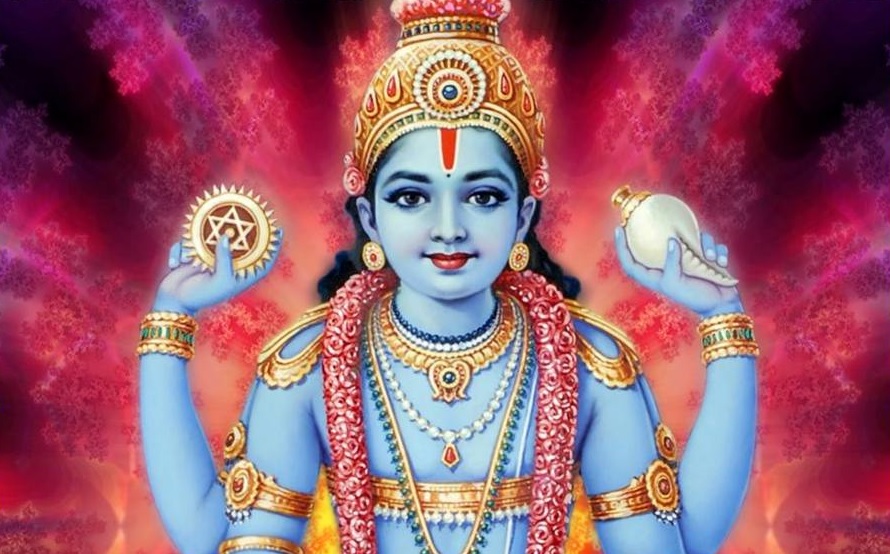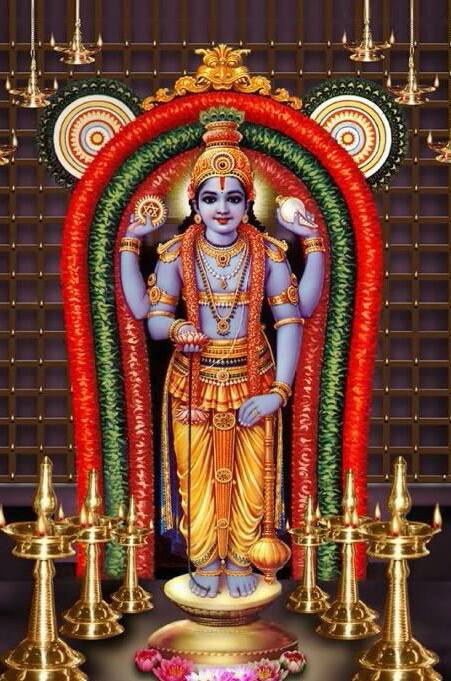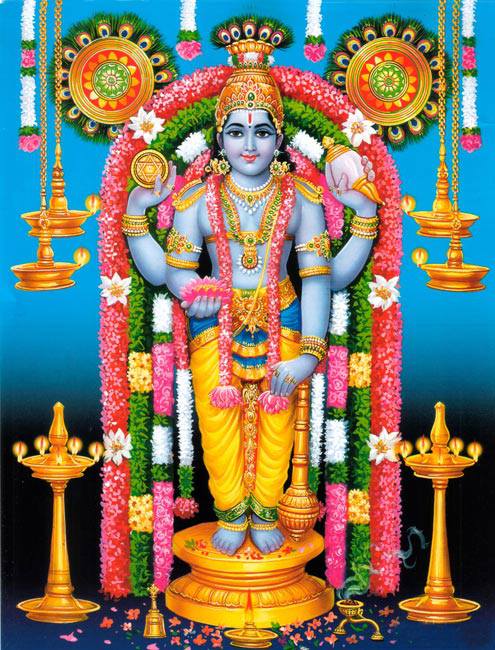No products in the cart.
Guruvayoorappan, is a form of Vishnu worshipped mainly in Kerela. He is the presiding deity of Guruvayoor temple, who is being worshiped as Shri Krishna in His child form (Balagopalan), popularly known as Guruvayur Unnikkannan (Guruvayur baby Krishna). Even though the deity is that of chatur bahu (four handed) Vishnu, the concept (Sankalpam) of the people is that the deity is the infant form of Lord Krishna.
Origin of Guruvayoorappan
King Sutapa and his wife Prishni prayed to Brahma for a child. Brahma, with the consent of Vishnu, gave the king a murti of Krishna given to him by Vishnu himself. It is said that by the grace of this murti, Brahma was able to fulfill his task of creation.
When Vishnu appeared before the King and the queen in answer to their prayers, they prayed to the Lord for a son like Him. As they repeated it thrice, the lord told them that they would have three janmas (births) and that He would be born to them in each of their three incarnations. In due course the Lord was born to them. He was born to them the first time as Prisnigarbha, who taught people the importance of brahmacharya. The second time, he was born to Kashyapa and Aditi and took form as the avatara of Vamana. In their third incarnation, they were Vasudeva and Devaki, parents of Krishna. The legend states that Krishna got the murti from his father and worshiped it at his capital, Dwaraka.
The holy idol or murti is almost 4 feet tall and made of a stone called “Patala Anjanam” or black bismuth and is in the standing pose with four arms, carrying the Panchajanya (shanku or conch), the Sudarshana Chakra (chakra or disc), the Koumodaki (gada or mace) and padma (lotus).
It is believed that the deity of Guruvayoorappan represents the purna rupa (full manifestation) of four-armed Vishnu revealed by baby Krishna to His parents, Devaki and Vasudeva, immediately after His advent in Kamsa’s jail. This idol was, therefore, worshipped by the parents of Krishna, and later was worshipped by Krishna, an Avatar of Vishnu Himself. So baby Krishna is worshipped on a Vishnu deity.
 Miracles of Guruvayoorappan
Miracles of Guruvayoorappan
Poonthanam Namboodiri was a humble devotee of Lord Guruvayurappan. He wrote a Malayalam lyric “Jnanappana” in praise of the Lord. He was not erudite like Bhattathiri but his lyrics were noted for their simplicity and devotional fervour. He requested Bhattathiri to revise it, but Bhattatiri lacked humility and looked down upon Poonthanam’s knowledge of Sanskrit. Poonthanam went home and wept bitterly before the Lord. That night a boy appeared at Bhattathiri’s house as he was preparing to recite Narayaneeyam. Seating the boy at his side, he started to recite. The boy pointed out an error in the very first verse. The poet admitted it and proceeded with the next verse, and the boy pointed out two mistakes. In the third verse, he pointed out three mistakes and so on. After the tenth verse, Bhattatiri realised that the boy was the Lord himself, and understood that Poonthanam’s bhakti was more pleasing to the Lord than his own superior knowledge of Vibhakti (Sanskrit grammar) and learning. He rushed to Poonthanam and sought his forgiveness. When he read the Jnanappana, he found that it was flawless.
Melpathur Narayana Bhattithiri was a devotee of Guruvayoorappan. He composed the 1034 verse Narayaneeyam, a summary of the Bhagavata Purana in 1586 AD. Melpathur Bhattithiri was a student of Achyuta Pisharody, who became ill. As a student of the guru, Melpathur Bhattithiri took the disease upon himself as part of Guru Dakshina. The disease was incurable, and he was instructed by Ezhuthachan to become a devotee of Guruvayoorappan. Being a Sanskrit scholar, Melpathur Bhattithiri composed a verse every day for the Lord, and after the final verse was complete, he was cured of his ailments.
King Manaveda told Vilwamangalam about his ambition to view Krishna. The next day the Swamiyar told him that Guruvayurappan has given his consent and Manavedan can see Guruvayurappan playing in the early hours of the morning at the platform of the Elanji tree.He could only see and not touch Him.When as per this agreement, Manavedan saw Guruvayurappan in the form of little child Sri Krishna, he was so excited that he forgot himself and, rushed to embrace little Sree Krishna.Guruvayoorappan immediately disappeared saying, “Vilwamangalam did not tell me that this will happen “.However, Manavedan got one peacock feather from the head gear of Bhagavan Krishna.
The peacock feather was incorporated in the headgear for the character of Sri Krishna in the dance drama Krishnanattam based on his own text krishnageeti which is composed of 8 chapters viz, Avatharam, Kaliyamardanam, Rasakrida, Kamsavadham, Swayamvaram, Banayuddham, Vividavadham and Swargarohanam. It was performed near the sanctum sanctorum of the Guruvayur Temple. On the ninth day, Avatharam was repeated as the Samoothiri felt that it was not auspicious to end the series with the demise of Lord Krishna.The blessed art form is still maintained by guruvayur devaswom and staged as an offering by devotees.
Sengalipuram Anantharama Dikshitar : In modern times, this well known scholar and Upanyasa Chakravati was cured of his leprosy by praying to Lord Guruvayurappan. His disease was advanced that the watchman did not allow him to take bath in temple tank. 3 or 4 years later, Dikshitar came to pray to Guruvayoorappan to the amazement of all. The miracle was due to his faithful recitation of Narayaneeyam.
Vilwamangalam Swamiyar and Kurur Amma were cousins. There is a holy spot, Nritham, on the eastern side of the northern entrance to the temple, where the Swamiyar meditated and danced in ectasy. Its believed that the Lord often gave him darshan in person after the last ritual of the day. He could see him whenever and in whatever form he wished. The Lord was a child to the childless Kururamma. She played with him and would even scold him when he was naughty. He helped her in all her household chores as a dutiful son would, for his mother.
The Garland of Manjula : There is a banyan tree a few metres away from the temple on the East Nada. A young Varasyar girl would make a garland every day and offer it to the Lord in the night. The Mel Shanti (Chief Priest) would adorn the idol with it. One day she was late and the Sri Koil was closed. Manjula stood near the banyan tree crying and Poonthanam who passed by told her “Guruvayoorappan knows what’s in your heart, keep the garland on the banyan tree and he will take it”. The following morning, when the Mel Shanti began to remove the nirmalyam, one garland stuck to the idol and would not come off. When Poonthanam saw this, he called out to the Lord saying “That’s Manjula’s Garland, let it also fall”. The garland fell and the devotees were awestruck and started chanting the Lord’s name. From that day the banyan tree is called Manjula.
Chembai Vaidyanatha Bhagavatar : He lost his voice suddenly at the peak of a concert he was giving at Suchindram. Several doctors tried to cure him but to no avail. He went to Guruvayur and cried out to the Lord. He regained his voice and lived many more years to sing in many concerts.
Coconut with horns : A villager had planted a number of coconut saplings and had promised himself that he would offer the ‘first coconut’ from each of his coconut trees to “The Lord Guruvayoorappan”. When the trees started to yield coconuts, he collected the first coconut from all the trees in a sack and set forth to Guruvayoor. On the way he was stopped by a robber and asked to part with the items in the sack. The villager told the robber that the coconuts in the sack belonged to Guruvayoorappan and so he was unable to hand it over. The robber disdainfully asked the villager “Is Guruvayoorappan’s coconut any different? Does it have horns?”. When the robber pulled the sack forcefully out of the villagers hands, the coconuts spilled out. To their astonishment each and every coconut in the sack had horns! Even today, the coconut with horns are displayed in the temple for devotees to see.
Shopkeeper and boy : Once, a poor little boy could not get even a morsel of food to appease his hunger, and stole a banana from a nearby fruit shop. Being a devotee of Lord Guruvayurappan, he dropped half the banana into the ‘hundi’ and he ate the other half. The shop-keeper caught hold of the boy and accused him of the theft. The boy admitted his guilt. The shop-keeper did not have the heart to punish this innocent boy, but to teach him a lesson, he ordered him to walk around the temple a certain number of times. The shop-keeper was aghast when he saw Lord Guruvayurappan follow the little boy around the temple. That night the Lord came to the shopkeeper in a dream and explained, “Since I have also had a share in the stolen banana I am bound to share the punishment, too. So, I followed the boy around the temple.”
Nenmini Unni : Once a Nenmini Namboodiri, the priest at the Guruvayur temple, instructed his twelve year old son to offer the Nivedyam to the Lord. There was only one priest in those days and the Nenmini Namboodiri had to go out on an urgent engagement. The son, Unni, offered a Nivedyam of cooked rice to the Lord; in his simplicity, he believed that the idol would eat the food, but the idol did not move. Unni bought some salted mangoes and curd from a neighborhood vendor, thinking that the Lord would prefer this, mixed the curd with rice and offered it again. The idol again remained unmoved. Unni cajoled, requested, coaxed and in the end threatened, but the idol remained unmoved. He wept because he believed he had failed and shouted at the Lord, exclaiming that his father would beat him. The Lord could not bear it any more, and made the Nivedyam disappear. The boy left the temple satisfied. Unni did not know that the Nivedyam offered to the Lord was the Variyar’s prerequisite. When Variyar returned to the temple, he saw the empty plate and became very angry with Unni, but Unni insisted that God had, in fact, eaten the offering. Unni’s innocent words made Variyar furious, as he believed the boy had eaten the offering himself and was lying. His father was about to beat Unni, but just then an Asareeri (celestial voice) was heard saying, “I am guilty. Unni is innocent”.
Guruvayoor Temple
The many centuries old Guruvayoor temple is located in the town of Guruvayoor, Thrissur, Kerala, India and is one of the most important temples of India. While non-Hindus are not permitted to enter the temple, Lord Guruvayoorappan has strong believers from many religions.
The word “Guruvayoorappan”, meaning “Lord of Guruvayoor”, comes from the words “Guru” referring to “Brihaspati”, the Guru of the Devas, ”Vayus”, the God of Wind, and ”Appan”, meaning ‘father’ or ‘Lord’ in Malayam. Since Guru and Vayu installed Krishna’s deity, the name Guruvayoorappan was given to the deity.
Construction of Guruvayur Temple
Before the conclusion of his incarnation as Krishna, the Lord told his devotee and minister Uddhava that his image would come floating in the sea which would soon engulf Dwaraka. Uddhava was to request Brahaspati, the Guru of the Gods, to install the image at a suitable place. When this came to pass, Brahaspati and Vayu, the God of wind, set out in search of a sacred place to house the murti. They met Parasurama (an earlier avatara of Vishnu) at Kerala, who was bringing the same murti to Dwaraka. Parasurama led them to a beautiful lake full of lotus flowers. Lord Shiva was doing penance there and he told Guru and Vayu to install the two murti together at a spot near the lake and that the site should be known as “Guruvayoopura”. Lord Shiva and the goddess Parvati left for Mammiyur, on the opposite bank of the lake.
The present tank, “Rudratirtha”, is only a miniature of the original lake. When devotees go round the Krishna temple, from a certain spot, they face Mammiyur and pray to Shiva. Vishwakarma, the architect of the Gods, built the Krishna temple at the request of Guru and Vayu. This is the account in the Mahabharatha, told by the sage Dattatreya to King Janamejaya, son of Parikshit.
An astrologer told a Pandya King that he was destined to die from a cobra bite on a particular day. He was advised to go and pray before Guruvayurappan. The king spent years in meditation and prayer at the feet of the deity. Suddenly the King realized that the time of his death had passed.
He came back to his palace and asked the astrologer why the prediction was wrong. The wise man showed him the mark on his left foot where the cobra had bitten him. Since the king was wholly absorbed in the Lord, Who alone can dispense with fate, he did not feel the sting.
In gratitude, the King built the Guruvayoorappan Temple and set apart funds for the daily routine of the temple. Most of the current temple building dates to the 16th and 17th centuries, although rich devotees funded extensions and additions later. The deepastamba (column of lights) was erected in 1836 by a devotee from Thiruvanathapuram. The temple has gopurams in the east and the west. The eastern gopuram has an inscription which refers to the town as “Gurupavanapura”. The western gopura was built in 1747.
Guruvayoor which is a bustling pilgrim town, is also hailed as “Bhuloka Sri Vaikuntham” meaning ‘Heaven on Earth’, where the deity reveals Himself to His devotees in the same majestic form in which He welcomes them in “Vaikuntha”, His celestial abode. It has its own glory and greatness, mainly because of the divinity enshrined in the Sanctum – Sanctorum (central shrine) of the temple and the unique charm of the idol installed in it. Mahavishnu, the presiding deity in the Garbhagraha (central shrine) is worshipped according to the pooja routines laid down by Adi Sankaracharya and later written in to the Tantrasamuchaya by Chennas Narayanan Namboodiri (born in 1427). The Chennas Namboodiris are the hereditary Tantri of Guruvayoor temple.
Rituals at Guruvayur Temple
There is a fascinating legend about the origin of the rituals in this temple. One Ekadesi day, Sri Adi Shankara and Narada were travelling in space above the Guruvayur Temple. Acharya did not notice the temple while passing over it. The deity pulled down acharya through the roof all of a sudden and in the next moment he was in front of the Lord. Acharya being immensely happy with the darshan of the Lord composed the Govindashtakam stotram at the very same spot. Acharya formed the principles for worship of the Lord on the request of the Lord himself. Even to this day these principles are followed very strictly without compromise.
Every day, the temple opens at 3 a.m. and the Lord is awakened from his sleep with the melodious notes of nadaswaram. The Lord is adorned with flowers of the previous day. This is known as Nirmalya Darshanam. It is believed that celestial beings come and worship the Lord after the temple is closed.
Sriveli is a ritual which is performed thrice every day. The Utsava Vigraha of the Lord (a miniature of the deity in gold) is mounted on an elephant and taken three times around within the four outer walls of the temple to the accompaniment of drums. There are beli Kallus representing the Lord’s body guards, subsidiary deities and members of his entourage in the inner and outer prakara. The idea of Sriveli and the priest performing poojas at these places is that the Lord Himself stands by as offerings are made to his dependents. Guruvayur is a temple state with the Lord as its Head. Every night at the close of worship, the days account is read to the Lord even today. Another ceremony is the Thulabharam, in which the devotees are weighed against plantains/sugar/jaggery/coconuts or other articles. These are gifted to the temple.
Another is Annaprasanam, or the first feeding ceremony of the child.








